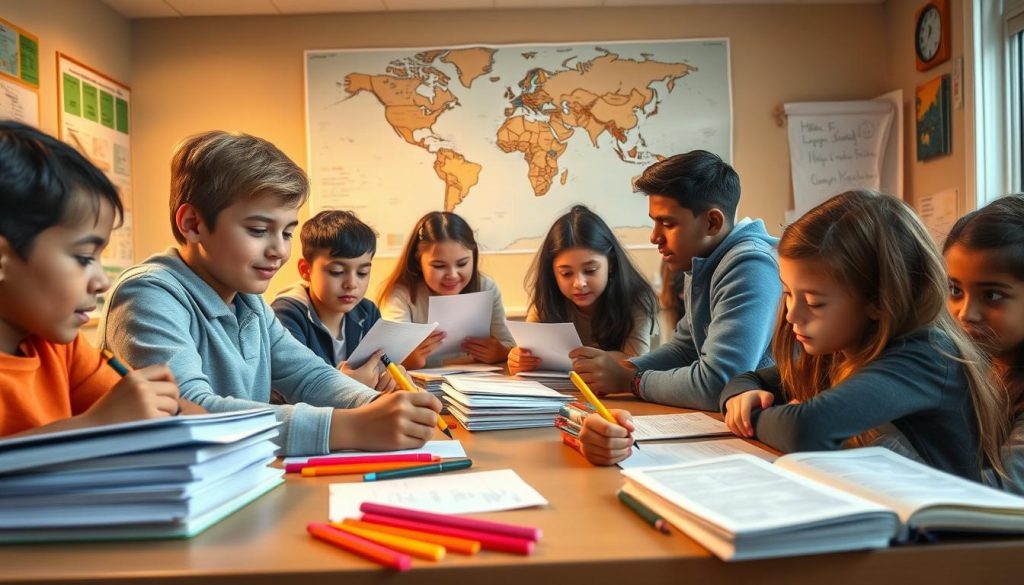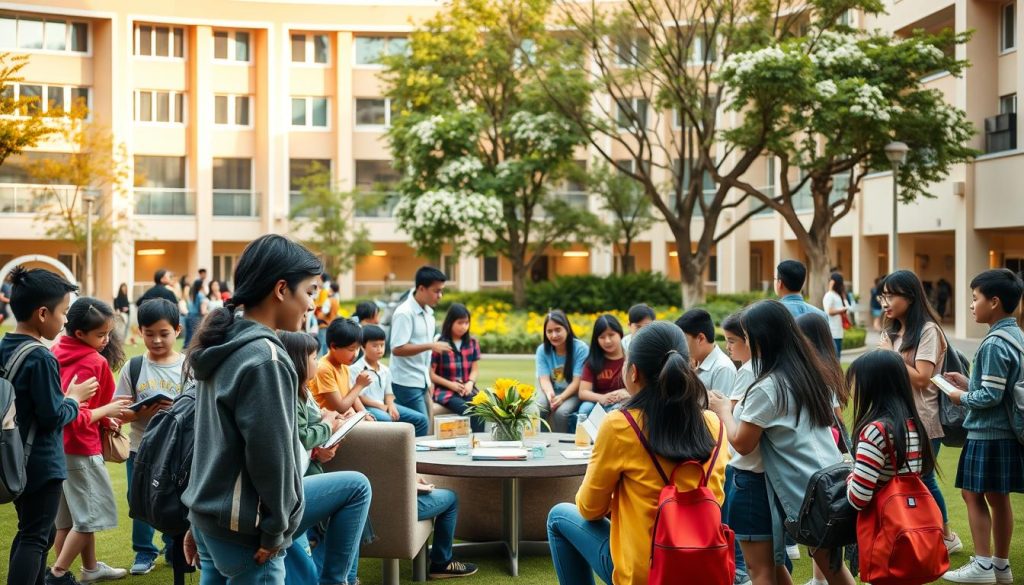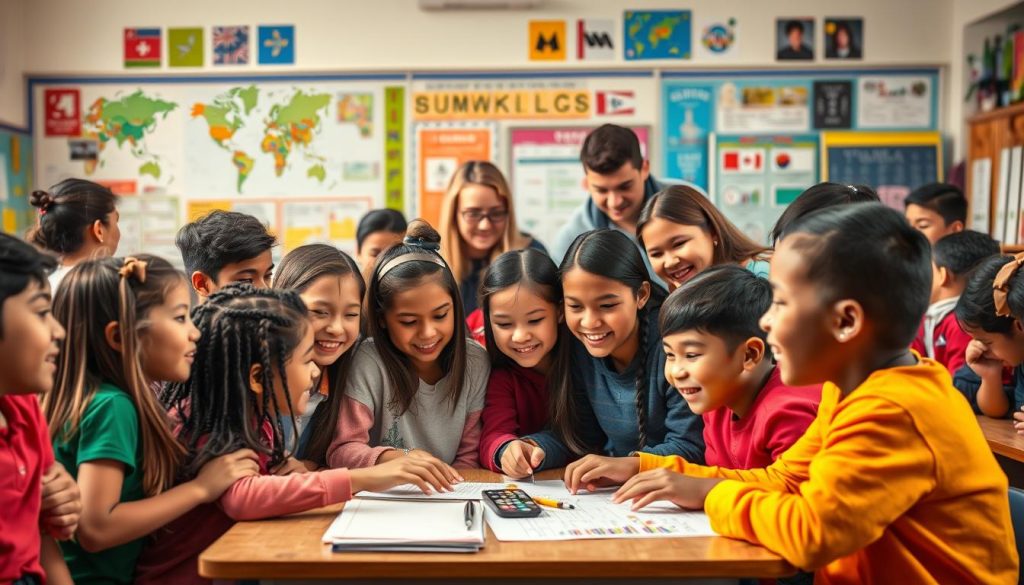Global connections in education are becoming increasingly important, and sister school collaborations are at the forefront of this movement.
These collaborations offer students a unique opportunity to engage in exchange programs and pen-pal programs, broadening their cultural understanding and fostering meaningful relationships.
By participating in these programs, students can gain a more nuanced understanding of different cultures and develop essential skills such as communication, empathy, and adaptability.
Key Takeaways
- Global connections in education are on the rise.
- Sister school collaborations offer unique opportunities for students.
- Exchange and pen-pal programs foster cultural understanding.
- Students develop essential skills through these programs.
- Meaningful relationships are formed through global connections.
What Are Sister School Programs?
International school connections are fostering global understanding through sister school programs. These collaborations have become a vital part of modern education, promoting cultural exchange and academic cooperation between schools across different countries.
Definition and Historical Background
Sister school collaborations refer to the partnerships formed between two or more educational institutions in different geographical locations, often in different countries. The concept has its roots in post-World War II international diplomacy, where educational exchanges were seen as a means to foster peace and understanding. Over time, these partnerships have evolved to include a wide range of activities, from student exchanges to joint research projects.
Different Models of School Partnerships
Sister school programs can take various forms, depending on the goals and resources of the participating schools. Some partnerships focus on language learning, while others emphasize cultural exchange or academic cooperation.
These partnerships can be either formal or informal. Formal arrangements typically involve official agreements outlining the terms of the partnership, including the responsibilities of each school and the duration of the collaboration. Informal arrangements, on the other hand, may involve more flexible and spontaneous interactions between schools, often initiated through personal connections between teachers or administrators.
Benefits of Sister School Collaborations
Sister school collaborations offer a wide range of benefits that enhance the educational experience for students and teachers alike. These partnerships are designed to foster global understanding and academic excellence.
Educational Advantages for Students
Student exchange programs provide educational exchange opportunities that are invaluable for personal growth and academic development. By participating in these programs, students can experience different educational systems, cultures, and languages, broadening their perspectives and enhancing their adaptability.
Some of the key benefits for students include:
- Exposure to new teaching methods and curricula
- Improved language skills through immersion
- Development of independence and self-reliance
Professional Development for Teachers
Teachers also benefit significantly from sister school collaborations. These partnerships offer professional development opportunities through workshops, training sessions, and collaborative projects. Teachers can share best practices, learn new methodologies, and develop their skills in a global context.
For instance, a teacher might participate in a professional development program that focuses on integrating technology into the classroom or developing culturally responsive teaching practices.
Community-Wide Cultural Enrichment
Sister school collaborations contribute to community-wide cultural enrichment by promoting cross-cultural understanding and exchange. These programs help to break down cultural barriers and foster a sense of global community.
| Benefit | Description | Impact |
|---|---|---|
| Educational Exchange | Students experience different educational systems | Broader perspectives and enhanced adaptability |
| Professional Development | Teachers share best practices and learn new methodologies | Improved teaching practices and global competence |
| Cultural Enrichment | Promotes cross-cultural understanding | Fosters a sense of global community |
By embracing sister school collaborations, educational institutions can provide students with global learning initiatives that prepare them for success in an increasingly interconnected world.
Exchange Programs: Immersive Cultural Learning
Through exchange programs, students can experience immersive cultural learning, broadening their perspectives and enhancing their educational journey. These programs facilitate cross-cultural partnerships, allowing students to engage deeply with foreign cultures.
Short-Term Exchange Visits
Short-term exchange visits provide a brief but impactful cultural immersion experience. Students can participate in cultural events, homestays, and educational activities, gaining a snapshot of life in a different country.
Semester and Year-Long Programs
For a more profound experience, semester and year-long programs allow students to fully integrate into a new educational system. They can develop language immersion skills and form lasting connections with host families and peers.
Host Family Experiences
Living with a host family is a crucial aspect of exchange programs, offering students a firsthand look at daily life in a foreign culture. This experience fosters cross-cultural understanding and provides a supportive environment for language development.
Selection and Preparation Process
The selection and preparation process for exchange programs involves careful matching of students with host families and schools. Participants receive guidance on cultural norms, expectations, and logistical arrangements to ensure a smooth transition.
Pen-Pal Programs: Building Global Friendships
Through pen-pal programs, students can develop meaningful relationships with peers from diverse backgrounds, enhancing their understanding of global cultures. These programs have been a staple in educational settings for decades, fostering cultural exchange and language skills.
Traditional Letter Writing Partnerships
Traditional letter writing remains a cherished method of communication in pen-pal programs. Students exchange handwritten letters, sharing stories about their daily lives, traditions, and experiences. This traditional approach helps develop writing skills and provides a tangible keepsake of the pen-pal relationship.
Digital Communication Methods
In today’s digital age, pen-pal programs have evolved to incorporate various digital communication methods. Email exchanges, video calls, and social media interactions have become increasingly popular, allowing for more frequent and diverse interactions between pen-pals. These digital tools facilitate real-time communication, bridging geographical gaps.
Structured vs. Free-Form Correspondence
Pen-pal programs can be structured with guided topics and activities or allow for free-form correspondence, where participants share as they wish. Structured programs often include curriculum-aligned topics, enhancing educational value. In contrast, free-form correspondence encourages creativity and personal connection. Both approaches have their merits, catering to different learning styles and preferences.
Some key benefits of pen-pal programs include:
- Enhanced cultural understanding
- Improved language skills
- Development of empathy and global awareness

Language Immersion Through International Connections
Sister school programs are at the forefront of language immersion, providing students with authentic language practice opportunities through international collaborations. By engaging with native speakers, students can improve their language skills in a more engaging and effective manner.
Authentic Language Practice Opportunities
International connections offer students the chance to practice languages in real-world contexts. Through pen-pal programs and virtual exchanges, students can engage in conversations with native speakers, enhancing their language proficiency.
- Improved pronunciation through regular interactions
- Enhanced vocabulary acquisition
- Better understanding of cultural nuances
Cultural Context for Language Acquisition
Understanding the cultural context is crucial for effective language acquisition. Sister school programs provide a unique opportunity for students to learn about different cultures while improving their language skills.
“Language learning is not just about memorizing rules and vocabulary; it’s about understanding the culture and context in which the language is spoken.”
Bilingual Project Collaboration
Bilingual project collaboration is another significant aspect of language immersion through international connections. Students can work together on projects, promoting mutual understanding and language practice.
By integrating language immersion into sister school programs, educational institutions can provide students with a comprehensive learning experience that combines language skills with cultural understanding.
How to Establish Sister School Partnerships
To initiate a sister school partnership, schools must first identify potential partners and build a foundation for collaboration. This process involves several key steps that can foster meaningful international relationships.
Finding Compatible Partner Schools
Identifying the right partner school is crucial for a successful sister school program. Schools should consider factors such as geographical location, cultural background, and educational focus when searching for a compatible partner.
- Research potential partner schools through international education networks and databases.
- Evaluate the compatibility of potential partners based on shared educational goals and values.
- Reach out to potential partners to gauge their interest in establishing a sister school relationship.
Initial Contact and Relationship Building
Once a potential partner is identified, the next step is to make initial contact and begin building a relationship. This can be achieved through various means, including email, video conferencing, and social media.
Key strategies for initial contact include:
| Strategy | Description |
|---|---|
| Personalized Email | Send a tailored email introducing the school and expressing interest in a sister school partnership. |
| Video Conferencing | Use platforms like Zoom or Skype to facilitate face-to-face communication. |
| Social Media Outreach | Leverage social media platforms to connect with potential partners and share information about the school. |
Creating Formal Agreements
After establishing a rapport with the partner school, it’s essential to create a formal agreement outlining the terms and expectations of the partnership.
Legal and Administrative Considerations
The formal agreement should address legal and administrative aspects, such as:
- Duration of the partnership
- Exchange programs and activities
- Responsibilities of each school
- Dispute resolution mechanisms
By following these steps and considering the legal and administrative aspects, schools can establish robust and meaningful sister school partnerships that foster cross-cultural understanding and international collaboration.

Funding Global Learning Initiatives
To make global learning initiatives a reality, schools need to identify and leverage diverse funding sources. Securing financial support is crucial for the success of sister school programs and educational exchange opportunities.
Federal and State Grant Opportunities
One of the primary sources of funding for global learning initiatives is federal and state grants. Programs such as the U.S. Department of Education’s Education Innovation and Research (EIR) program provide significant funding for innovative educational projects, including international collaborations.
Private Foundation Support
Private foundations also play a vital role in supporting global learning initiatives. Foundations like the Bill and Melinda Gates Foundation and the Open Society Foundations offer grants for educational projects that promote global understanding and cultural exchange.
Community Fundraising Strategies
Community fundraising is another effective way to support global learning initiatives. Schools can organize events, crowdfunding campaigns, and corporate sponsorships to raise funds for their programs.
Cost-Sharing Models with Partner Schools
Implementing cost-sharing models with partner schools can also help in funding global learning initiatives. By sharing costs, schools can make their programs more financially sustainable.
Technology Tools for Cross-Cultural Partnerships
In today’s interconnected world, technology plays a vital role in fostering cross-cultural partnerships between schools. By leveraging various digital tools, educational institutions can enhance collaboration, improve communication, and create meaningful exchange experiences.

Virtual Meeting Platforms
Virtual meeting platforms have become essential for facilitating face-to-face interactions between students and teachers from different countries. Tools like Zoom, Google Meet, and Microsoft Teams enable real-time communication, allowing participants to engage in discussions, share ideas, and build relationships.
Collaborative Project Management Tools
To facilitate joint projects and assignments, schools can utilize collaborative project management tools such as Trello, Asana, or Google Workspace. These platforms enable students to work together on documents, track progress, and share resources efficiently.
Translation and Language Support Resources
Language barriers can be a significant challenge in cross-cultural partnerships. To overcome this, schools can employ translation tools like Google Translate or Microsoft Translator, which provide real-time language support. Additionally, language learning apps can help students improve their language skills and communicate more effectively.
Digital Security and Student Privacy
When using technology tools for cross-cultural partnerships, it’s crucial to prioritize digital security and student privacy. Schools must ensure that they comply with relevant data protection regulations and implement robust security measures to safeguard sensitive information.
Overcoming Challenges in International School Connections
The journey of creating and maintaining international school connections is not without its hurdles. As schools worldwide engage in sister school programs, they often encounter various obstacles that can impact the success of these partnerships.
Time Zone and Academic Calendar Differences
One of the primary challenges is managing different time zones and academic calendars. Schools in different parts of the world may have varying schedules, making it difficult to coordinate activities or meetings. To overcome this, schools can use virtual meeting tools that allow for flexible scheduling. They can also plan ahead, creating a shared calendar that accounts for different holidays and academic breaks.
Cultural Misunderstandings and Resolution
Cultural differences can sometimes lead to misunderstandings. It’s essential for schools to foster an environment of cultural sensitivity and open communication. Providing cultural training for teachers and students can help bridge the gap. When misunderstandings arise, they should be addressed promptly through open dialogue, ensuring that all parties are heard and understood.
Maintaining Long-Term Engagement
To maintain long-term engagement, schools should regularly assess and adjust their partnership activities. This can involve setting clear goals, celebrating achievements, and continually seeking feedback from all stakeholders. Engaging in collaborative projects that are meaningful to both parties can also help sustain interest and commitment.
Administrative and Logistical Hurdles
Administrative tasks, such as visa arrangements for exchange students or managing financial transactions across borders, can be daunting. Schools can simplify these processes by establishing clear protocols and leveraging technology, such as online payment systems and document management tools.
By understanding and addressing these challenges, schools can strengthen their international connections, fostering a more enriching experience for students, teachers, and the broader community.
- Establish clear communication channels
- Be flexible and adaptable
- Leverage technology to simplify processes
- Foster cultural understanding and sensitivity
Success Stories: Transformative Educational Exchange Opportunities
The impact of sister school programs is best seen through the success stories of students and educators who have benefited from these transformative educational exchange opportunities. These programs have not only enhanced academic learning but have also fostered global understanding and friendships.
Elementary School Partnerships
Elementary school partnerships have shown remarkable success in introducing young students to global perspectives. Through pen-pal programs and virtual exchanges, students have learned about different cultures and developed empathy and understanding.
Secondary School Exchange Programs
Secondary school exchange programs have provided students with immersive cultural experiences, enhancing their language skills and broadening their worldview. Students have reported increased confidence and a more nuanced understanding of global issues.
Virtual Exchange Success During Global Challenges
During the pandemic, virtual exchange programs proved to be a resilient and effective way to maintain educational exchange opportunities. Educators adapted quickly, leveraging technology to keep students connected across borders.
Pandemic-Era Adaptations
The pandemic era saw a significant shift towards virtual exchange programs, with schools adopting innovative methods to continue their sister school initiatives. As one educator noted,
“The pandemic taught us the importance of flexibility and creativity in maintaining global connections.”
These success stories demonstrate the power of educational exchange opportunities in fostering global citizenship and preparing students for an increasingly interconnected world.
Measuring Impact of Student Exchange Programs
To understand the full benefits of student exchange programs, it’s essential to measure their impact on academic performance and cultural competency. Evaluating the success of these programs requires a multifaceted approach that considers various performance indicators.
Academic Performance Indicators
One of the primary ways to measure the impact of student exchange programs is through academic performance indicators. This includes assessing students’ grades, test scores, and overall academic achievement before, during, and after their exchange experience. Research has shown that participants in exchange programs often exhibit improved academic performance due to increased motivation and exposure to different teaching methods.
Cultural Competency Development
Cultural competency is another critical aspect to evaluate. This involves assessing students’ ability to understand and interact with different cultures. Surveys, feedback forms, and cultural competency tests can be used to measure this development. Participants in exchange programs typically show significant improvements in their cultural understanding and adaptability.
Long-Term Educational and Career Outcomes
The long-term impact of student exchange programs on educational and career outcomes is also significant. Studies have found that exchange program alumni are more likely to pursue higher education and careers in international fields. Tracking the career paths of former exchange students can provide valuable insights into the lasting effects of these programs.
Community Engagement Metrics
Finally, measuring community engagement is crucial. This involves assessing how exchange program participants contribute to their communities upon returning. Metrics can include volunteer work, participation in cultural events, and leadership roles. High levels of community engagement indicate a positive impact on both the individual and the community.
By examining these areas, educators and policymakers can gain a comprehensive understanding of the impact of student exchange programs. This information is vital for refining program structures and ensuring they continue to provide valuable experiences for participants.
Conclusion: The Future of Sister School Programs
Sister school collaborations have emerged as a vital component in global learning initiatives, fostering cultural understanding and educational exchange among students worldwide. As we have explored, these programs offer a range of benefits, from language immersion and cultural competency development to professional development for teachers and community-wide cultural enrichment.
The future of sister school programs looks promising, with technology playing a crucial role in bridging geographical gaps and facilitating international connections. Virtual meeting platforms, collaborative project management tools, and translation resources are making it easier for schools to establish and maintain partnerships across borders.
As sister school collaborations continue to evolve, they are likely to have a profound impact on the future of global learning initiatives. By promoting cross-cultural understanding and educational exchange, these programs can help shape a more interconnected and informed global community.
FAQ
What is a sister school program?
A sister school program is a partnership between two or more schools in different locations, often in different countries, that aims to promote cultural understanding, educational exchange, and global learning initiatives through various collaborations, including exchange programs and pen-pal programs.
What are the benefits of sister school collaborations?
Sister school collaborations offer numerous benefits, including educational advantages for students, professional development for teachers, and community-wide cultural enrichment, ultimately fostering global citizenship and cross-cultural understanding.
How do exchange programs work?
Exchange programs involve students or teachers from one school visiting and staying with a host family or school in another location, often in a different country, to immerse themselves in a new culture, learn new languages, and develop global perspectives.
What are the different types of exchange programs available?
There are various types of exchange programs, including short-term exchange visits, semester and year-long programs, and host family experiences, each offering unique opportunities for cultural immersion and educational growth.
How can schools establish sister school partnerships?
Schools can establish sister school partnerships by finding compatible partner schools, making initial contact, building relationships, and creating formal agreements, while also considering legal and administrative aspects.
What funding options are available for global learning initiatives?
Funding options for global learning initiatives include federal and state grant opportunities, private foundation support, community fundraising strategies, and cost-sharing models with partner schools, providing various avenues for securing financial support.
How can technology facilitate cross-cultural partnerships?
Technology can facilitate cross-cultural partnerships through virtual meeting platforms, collaborative project management tools, translation and language support resources, while also ensuring digital security and student privacy.
What are some common challenges in international school connections?
Common challenges in international school connections include time zone and academic calendar differences, cultural misunderstandings, administrative and logistical hurdles, and maintaining long-term engagement, requiring creative solutions and strategic planning.
How can the impact of student exchange programs be measured?
The impact of student exchange programs can be measured through academic performance indicators, cultural competency development, long-term educational and career outcomes, and community engagement metrics, providing insights into their effectiveness.
What is the role of pen-pal programs in building global friendships?
Pen-pal programs play a significant role in building global friendships by facilitating traditional letter writing partnerships, digital communication methods, and structured or free-form correspondence, fostering cultural understanding and exchange between students from different backgrounds.
How do sister school programs promote language immersion?
Sister school programs promote language immersion by providing authentic language practice opportunities, cultural context for language acquisition, and bilingual project collaboration, ultimately enhancing language skills and cultural competence.




